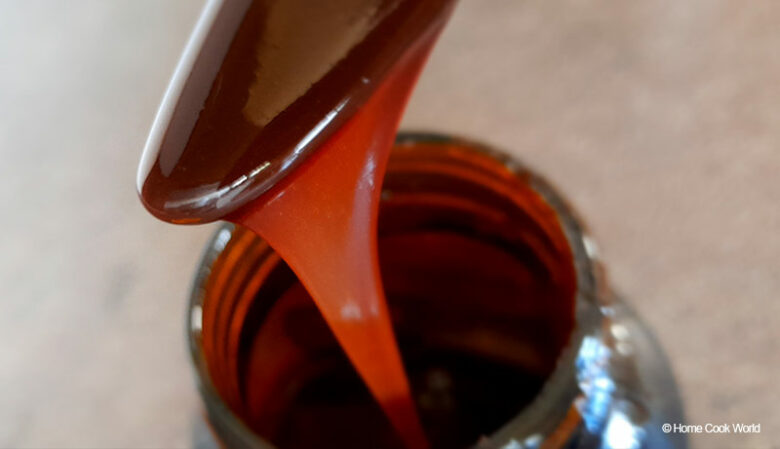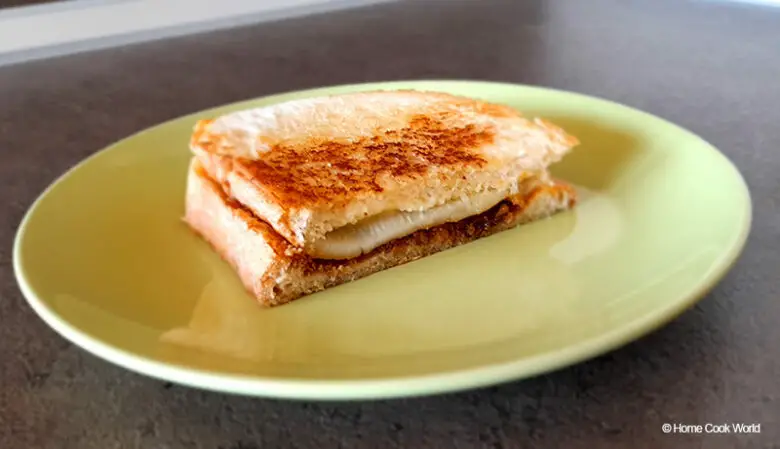The gooey black stuff called Marmite is another strange food obsession the Brits have that they hold dear to their hearts (even if they don’t like it). It’s a national treasure, regarded on almost the same level as the legendary English breakfast.
Its dark, thick nature may look unusual (and not the least bit appetizing), but there’s a lot you can do with this gunky stuff and the more you experiment with it, the more you’ll end up loving it.
What Is Marmite?
Marmite is a dark, thick yeast extract spread with a salty taste that’s primarily eaten on toast and is particularly popular in the United Kingdom. Its flavor is unique and polarizes people, even leading the company to take up the slogan “Love It or Hate It.”
Like most yeast extracts, Marmite is high in sodium but also high in B vitamins, and is suitable for vegetarians.
The below table contains Marmite’s nutritional information shown on Marmite jars.
| Marmite Nutrition Facts | Per 100 g |
|---|---|
| Energy | 262 kcal |
| Fat of which saturated | < 0.5 g < 0.1 g |
| Carbohydrates of which sugars | 30 g < 1.2 g |
| Protein | 34 g |
| Sodium (salt) | 10.8 g |
| Thiamin | 77 mg 700% NRV |
| Riboflavin | 6.8 mg 485% NRV |
| Niacin | 69 mg 432% NRV |
| Folic acid | 1250 μg 960% NRV |
Nutrient reference values (NRVs) stands for a set of nutritional values used in nutrition labeling derived from authoritative recommendations for the optimum daily nutrient intake.
How Is Marmite Made?
Marmite is made from the byproduct of beer brewing. The byproduct is broken down into yeast extract, made into a concentrate, and blended with ‘secret ingredients’.
Food Unwrapped explored the process of how Marmite is made. They revealed the following:
Breweries create beer by adding yeast to a sugary solution to create alcohol. When the process is finished, they end up with seven times more yeast. This yeast can then be sold on to make “yeast extract.”
At Marmite’s factory, the byproduct is pumped into large vats called “coppers.” In the coppers, the temperature is adjusted to 203°F (95°C) so the yeast decays which kills the live yeast and breaks down their cell walls.
This substance is then broken down into two liquids—the broken cell walls and the cell innards, which is the actual yeast extract.
The yeast extract is then heated up, much of the moisture evaporates and leaves behind a concentrated substance, which closely resembles what we call Marmite.
It is at this point “secret ingredients” are blended with the concentrated yeast extract. According to the back of the jar, these additional ingredients include barley, salt, vegetable juice concentrate, and celery.
The Best Ways to Use Marmite

Marmite is usually spread thinly on toast and consumed for breakfast but there are a variety of other ways to use it, including as a marinade for chicken or to add extra flavor to soups, and sauces.
Let’s look at a few:
Grilled Marmite and Cheese Toastie

Super easy to make. Spread Marmite on one slice, add cheese. On the other slice add mayonnaise and put the sandwich together.
On the top and bottom of the sandwich add butter. Grill in a frying pan till the bread is toasted and it’s ready.
Marmite and Noodles on Toast

Cook noodles (in this example, Maggi instant noodles were used) and spread Marmite on two slices of bread. Ideally, you want the noodles to not be too wet and runny (gooey is best) because it will soak through the bread.
Add a cheese of your choice (Red Leicester was used in this example). And place in the oven until the cheese is melted.
Marmite Spaghetti

Another weird but very easy Marmite recipe to make. First, put some spaghetti on the boil in the background.
In the meantime, grab a bowl and mix melted butter, a spoonful of Marmite (seriously, no more than a spoon!), some black pepper and chop up some garlic. Mix them and add to the spaghetti when it’s ready.
And at the very end, some parmesan on top. Marmite is already very high in sodium, so no need to add any salt. You may also wish to add extra stuff to this one like meat or chicken. The above recipe was inspired by Nigella Lawson‘s.
Marmite Chicken

A spoonful of Marmite can make a great marinade exceptional. With chicken, in particular, Marmite can add an awesome kick but usually accompanies other ingredients.
The above sauce was made with honey, Marmite, oil, and vinegar and was inspired by Emanuelle Lee’s Glazed Marmite & Honey Chicken With Lemony Potatoes recipe.
You may wish to add a bit more Marmite to make the marinade/sauce thicker and hold onto the chicken. And though Marmite is generally quite salty, you may still want to add a bit of salt to this one.
There are several recipes for Malaysian Marmite chicken and chef Luiz Hara has made his own twist too. Sainsbury’s also has a simple Marmite butter roasted chicken recipe.
For more recipes, you can also check Marmite’s website or any of the recipes from Vegemite. Other more inventive recipes can be found online (there’s an endless supply of new ways people have found to use this ‘black magic’).
The Guardian‘s Stuart Heritage also uncovered several unusual Marmite recipes too (including a Marmite smoothie!).
Where Does Marmite Come From?
Marmite is produced by Unilever, a British multinational consumer goods company and is manufactured in Burton upon Trent, UK.

What we now call ‘Marmite’ was invented by German scientist Justus von Liebig in the late 1800’s. He discovered that brewer’s yeast—the byproduct of brewing beer—could be made into a concentrate and consumed.
But as a product, Marmite was first introduced and branded by Marmite Food Extract Company in 1902 with Marmite being their primary product. They also chose Burton upon Trent for their factory because it was close to the Bass Brewery.
Marmite became a popular brand 10 years later in 1912 when it was discovered that it was rich in several B vitamins. It also became popular among vegetarians as a meat-free substitute for beef extracts.
Marmite is also licensed to be produced in New Zealand, but the recipe is not the same, so don’t expect the same taste.
How Long Does Marmite Last?
Marmite is stored in a kitchen cupboard and can remain left out for however long is recommended on the product so check the bottom of the label at the back.
Typically, though, Marmite is recommended to be consumed within 18 months—but not because of health reasons. As Marmite quality specialist St. John Skelton explained to the Daily Mail:
“We put 18 months on the jar, because that’s how long it retains its vitamin content. But you could eat Marmite that was manufactured in 1945 and it would be safe. Its flavour would have changed, but it would still taste good.”
John Skelton (as quoted by Daily Mail)
The amount of salt in the product makes it a ‘shelf-stable’ food, according to food microbiology professor John Brooks.
Otherwise known as ‘ambient food’, shelf-stable means it can be safely stored at room temperature without issue if it’s in a sealed container.
Supposedly, the salt in Marmite acts like a natural preservative and means that it rarely goes off.
While you could store Marmite in a fridge, it is not usually seen as a good idea. It can make Marmite solid and difficult to spread.
Can I Freeze Marmite?
While Marmite can be frozen it is not usually seen as necessary. Because of its long shelf life, it can be left on the side or in the kitchen cupboard.
If you do decide to freeze Marmite, you should have no problem placing it in the freezer in a sealed container.
Do note that if you freeze a Marmite sandwich, the Marmite will soak into the bread, which could affect the taste.
The best way to thaw Marmite is by letting it defrost naturally at room temperature, though this will likely take a few hours. You could also microwave a small amount if you wish.
But do note that when you retrieve Marmite from the freezer it will be awfully hard and you will not be able to spread it until it is defrosted.
Can I Use Marmite Instead of Yeast?
Marmite is a ‘yeast extract’ which means the yeast cells are dead and have been broken down to their remaining innards, so it’s not the same as actual yeast.Plus, Marmite includes additional ingredients for flavor, so it is not exactly pure yeast extract (check How is it Made above).
So, in other words, you can’t use Marmite as a substitute for instant yeast if you are planning on making something like bread. However, supposedly you can by adding warm water, but the process will be much slower (and expect a very different taste).(FYI—There are also recipes online for Marmite bread, but instead of substituting Marmite for yeast, they use both and the Marmite acts more like a flavoring.)
Are Marmite and Vegemite the Same?
Marmite and Vegemite are not the same though they are quite similar in several ways. Most obviously, the two are thick black savory pastes usually eaten on toast.
The branding of the two is quite similar too. Both use a yellow and red theme with a white font and Vegemite’s name derives from Marmite.
An easy way to remember the difference between the two is that Marmite comes from the UK while Vegemite comes from Australia.
Most people agree that Marmite and Vegemite more or less taste the same, but there are plenty who disagree. Some even consider Vegemite to have a stronger taste.
According to Mashed, Marmite has a salty-sweet taste while Vegemite is more bitter and yeasty.
They also explain that Vegemite has a jet-black color and a thickness like peanut butter while Marmite is more like a dark brown color and has a consistency similar to syrup or honey.
All that aside, in most instances you can substitute Marmite and Vegemite for each other when there are no other options.
Where Is Marmite Sold?
Marmite can be hard to find in the US, but it usually can be found at Walmart, Kroger, or Publix. Unfortunately, Marmite is not carried by Trader Joe’s and Sprouts.
You can usually find Marmite in the condiments aisle where you would usually find other jarred products such as jam or peanut butter, or sauces like ketchup and mustard.
If you are unable to find Marmite, you can try substituting it with Vegemite. According to Miss Vickie, aside from Vegemite, some of the best substitutes for Marmite include Promite and Tesco Yeast Extract (which will probably be difficult to get outside the UK).
Other well-known alternatives are the Brazilian Cenovit and the Swiss Cenovis. Both of which are dark brown and typically spread on toast.You can also order Marmite from Amazon.
Can I Carry Marmite on a Plane?
If you are traveling by plane with Marmite, it is best to store it in your luggage as you may have issues carrying Marmite in your hand luggage if they decide it is a liquid.
According to the US Transportation Security Service, liquids are limited to travel-size containers that are 3.4 ounces (100 milliliters) or less.
So, if you absolutely must travel with Marmite in your hand luggage only take a small package no bigger than 3.4 ounces.
Interestingly, according to the Express, London City Airport revealed that Marmite is their most confiscated brand of food.
Can I Send Marmite Through the Mail?
There is some confusion online about sending Marmite in the mail. It is not classed as a toxic substance. Marmite is usually classified as a condiment and can be sent without issue (just make sure you declare it properly to avoid fees).
Rumors spread online that Marmite could not be sent in the mail because it was toxic and banned by the Geneva convention, but this originated from a joke by a Canadian commenting on a forum on TripAdvisor several years ago.
To further add to the confusion, a shipment that contained Marmite was rejected from entering Canada in 2020.
But this was because the shipment also contained meat products that didn’t have the correct documentation, not because of the Marmite, as explained by the Canadian Food Inspection Agency.Marmite has also never been banned in Denmark either. As a fortified food with added vitamins, it meant that it could not be marketed unless approved by Danish food authorities.
